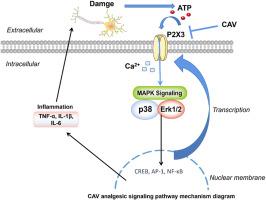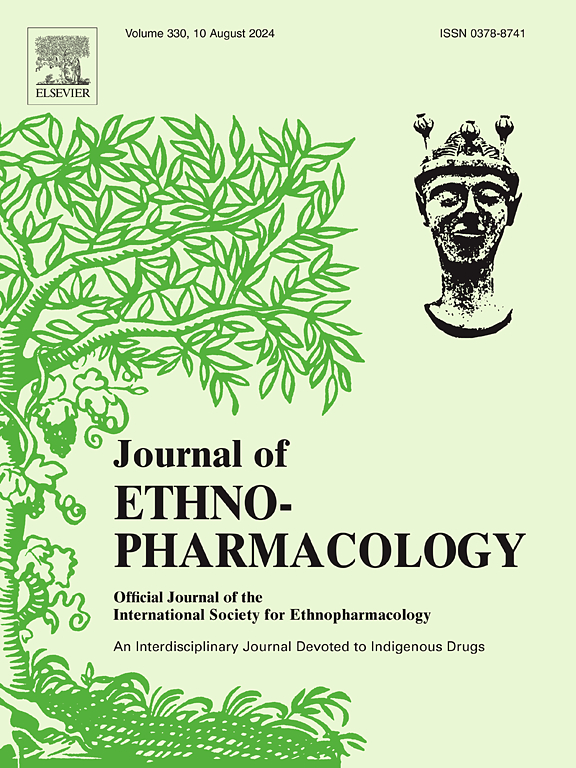The analgesic effect and mechanism of the active components screening from Corydalis yanhusuo by P2X3 receptors
IF 4.8
2区 医学
Q1 CHEMISTRY, MEDICINAL
引用次数: 0
Abstract
Ethnopharmacological relevance
Cavidine (CAV) is the main bioactive ingredient of Corydalis ternata f. yanhusuo (Y.H.Chou & Chun C.Hsu) Y.C.Zhu, which is a traditional Chinese herbal containing a variety of uses such as analgesic, anticancer, and anti-inflammatory properties.
Aim of the study
The goal is to screen Corydalis yanhusuo for anti-central sensitization active components and investigate and clarify the pharmacological mechanism and therapeutic efficacy of the active ingredient CAV in the treatment of chronic pain.
Material and methods
First, cell membrane immobilized chromatography was used to screen the bioactive ingredients in Corydalis yanhusuo. Spare nerve injury (SNI) model and complete Freund's adjuvant (CFA) mice model were constructed to identify the analgesic effect of CAV. RNA-seq and bioinformatics analyses were used to explore the potential targets of CAV in CFA mice and SNI mice. HE staining was used to observe the infiltration of inflammatory cells in the dorsal root ganglion (DRG) and spinal cord(SC) of CFA mice and SNI mice. WB and qPCR were used to detect the level of inflammatory factors TNF-α, IL-1β, and IL-6 in DRG and SC of mice. SNI and CFA mice were used to study the effect and mechanism of CAV on microglial activation.
Results
9 potential active ingredients were screened out from Corydalis yanhusuo that can regulate P2X3 receptors. CAV showed good analgesic effects, increased the mechanical pain and thermal pain thresholds of CFA mice and SNI mice, inhibited the expression of DRG and SC inflammatory factors, downregulated IBA-1, and inhibited microglial activation. Further in vivo and in vitro experiments showed that CAV significantly inhibited the expression of P2X3 receptors and the activation of its downstream MAPK pathway in DRG neurons and SC.
Conclusion
This study is the first to indicate that CAV exerts an analgesic effect by inhibiting microglia activation via the P2X3 signaling pathway axis, providing the clinical utility of CAV in chronic pain therapy.

通过 P2X3 受体从延胡索中筛选出的活性成分的镇痛作用及其机制
民族药理学意义:Cavidine(CAV)是Corydalis ternata f. yanhusuo(Y.H.Chou & Chun C.Hsu)Y.C.Zhu的主要生物活性成分,而Corydalis ternata f. yanhusuo(Y.H.Chou & Chun C.Hsu)Y.C.Zhu是一种传统中草药,具有镇痛、抗癌和抗炎等多种用途:研究目的:筛选延胡索中的抗中枢敏化活性成分,研究并阐明活性成分 CAV 治疗慢性疼痛的药理机制和疗效:首先,采用细胞膜固定色谱法筛选延胡索中的生物活性成分。材料和方法:首先,采用细胞膜固定色谱法筛选延胡索中的生物活性成分;然后,构建备用神经损伤(SNI)模型和完全弗氏佐剂(CFA)小鼠模型,以确定CAV的镇痛效果。通过RNA-seq和生物信息学分析探索CAV在CFA小鼠和SNI小鼠中的潜在靶点。HE 染色用于观察 CFA 小鼠和 SNI 小鼠背根神经节(DRG)和脊髓(SC)中炎性细胞的浸润情况。用WB和qPCR检测小鼠DRG和SC中炎性因子TNF-α、IL-1β和IL-6的水平。用 SNI 和 CFA 小鼠研究 CAV 对小胶质细胞活化的影响和机制:结果:从延胡索中筛选出9种能调节P2X3受体的潜在活性成分。CAV具有良好的镇痛作用,能提高CFA小鼠和SNI小鼠的机械痛和热痛阈值,抑制DRG和SC炎症因子的表达,下调IBA-1,抑制小胶质细胞活化。进一步的体内和体外实验表明,CAV 能显著抑制 DRG 神经元和 SC 中 P2X3 受体的表达及其下游 MAPK 通路的激活:该研究首次表明,CAV通过P2X3信号通路轴抑制小胶质细胞的激活,从而发挥镇痛作用,为CAV在慢性疼痛治疗中的临床应用提供了依据。
本文章由计算机程序翻译,如有差异,请以英文原文为准。
求助全文
约1分钟内获得全文
求助全文
来源期刊

Journal of ethnopharmacology
医学-全科医学与补充医学
CiteScore
10.30
自引率
5.60%
发文量
967
审稿时长
77 days
期刊介绍:
The Journal of Ethnopharmacology is dedicated to the exchange of information and understandings about people''s use of plants, fungi, animals, microorganisms and minerals and their biological and pharmacological effects based on the principles established through international conventions. Early people confronted with illness and disease, discovered a wealth of useful therapeutic agents in the plant and animal kingdoms. The empirical knowledge of these medicinal substances and their toxic potential was passed on by oral tradition and sometimes recorded in herbals and other texts on materia medica. Many valuable drugs of today (e.g., atropine, ephedrine, tubocurarine, digoxin, reserpine) came into use through the study of indigenous remedies. Chemists continue to use plant-derived drugs (e.g., morphine, taxol, physostigmine, quinidine, emetine) as prototypes in their attempts to develop more effective and less toxic medicinals.
 求助内容:
求助内容: 应助结果提醒方式:
应助结果提醒方式:


